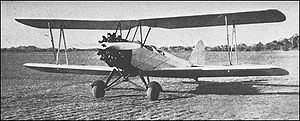Tachikawa Ki-17 Video - Picture

|
|
Tachikawa Ki-17
Ki-17

Picture - Tachikawa Ki-17
Role: Military training aircraft
Manufacturer: Tachikawa Aircraft Company Ltd
First flight: July 1935
Primary user: Imperial Japanese Army Air Academy
Produced: 1936 - 1943
Number built: 560
The Tachikawa Ki-17 (Kyugoshiki san-gata renshuki) was a basic training aircraft of the Imperial Japanese Army Air Force built by Tachikawa Aircraft Company Ltd in the 1930s. It was known to the Allies under the nickname of Cedar during World War II.
Design and development
The Ki-9 was originally planned to be manufactured in two versions using the same basic airframe, but with different engines for service as either a primary or intermediate trainer. However, when the lower-powered form proved to be unsuitable due a center of gravity issue, design of a new airframe was ordered for the basic trainer version, and was given the new designation of Ki-17.
Compared to the Ki-9, the Ki-17 had equal-span wings, a slimmer fuselage and a revised tailplane. It was powered by a 112 kW (150 hp) Hitachi Ha-13a radial engine. The first prototype flew in July 1935.
The only major change made to subsequent production aircraft was the deletion of the upper-wing ailerons to eliminate oversensitive control inputs.
Operational history
The Ki-17 was introduced to service as the âArmy Type 95-3 Basic Grade Trainer Model Aâ under the former aircraft naming nomenclature system. Tachikawa manufactured 560 Ki-17s between 1936 and 1943 and the type saw service with the Army Air Academy and flight training schools.
Operators
Japan
Kumagaya Army Flying Training School
Mito Army Flying Training School
Tachiari Army Flying Training School
Utsonomiya Army Flying Training School
Imperial Japanese Army Air Force Academy (Rikugun KÅku Shikan GakkÅ)
Thailand
Royal Thai Air Force
Specifications (Ki-17)
Data from Japanese Aircraft of the Pacific War
General characteristics
Crew: 2
Length: 7.85 m (25 ft 9 in)
Wingspan: 9.82 m (32 ft 3 in)
Height: 2.95 m (9 ft 8 in)
Wing area: 26.2 m² (281.91 ft²)
Empty weight: 639 kg (1,408 lb)
Loaded weight: 914 kg (2,014 lb)
Powerplant: 1x Hitachi Ha-12 seven-cylinder air-cooled radial engine, 112 kW (160 hp)
Performance
Maximum speed: 170 km/h (106 mph)
Cruise speed: 150 km/h (81 mph)
Service ceiling: 5,300 m (17,390 ft)
Rate of climb: 3.3 m/s (656 ft/min)
Wing loading: 34.6 kg/m² (7.1 lb/ft²)
Power/mass: 0.12 kW/kg (0.07 hp/lb)
Endurance: 3.5 hours
Comparable aircraft
de Havilland Tiger Moth
Bibliography
Francillon, René J. Japanese Aircraft of the Pacific War. London: Putnam & Company Ltd., 1979. ISBN 0-370-30251-6. (new edition Putnam Aeronautical Books, 1987. ISBN 0-85177-801-1.)
Tachikawa Ki-17 Pictures
Living Warbirds: The best warbirds DVD series.
Source: WikiPedia